I am planning to grow vegetables on my balcony and wanted to know which ones I can grow. I could not find a detailed list so I’ve created one after my research. You can use this list to choose vegetables to grow on your balcony.
Vegetables that can be grown on a balcony include tomatoes, peppers, okra, radish, carrots, peas, onions, cabbage, cauliflower, beets, chard, cilantro, mint, sage, thyme, cucumber, spinach, broccoli.
Herbs
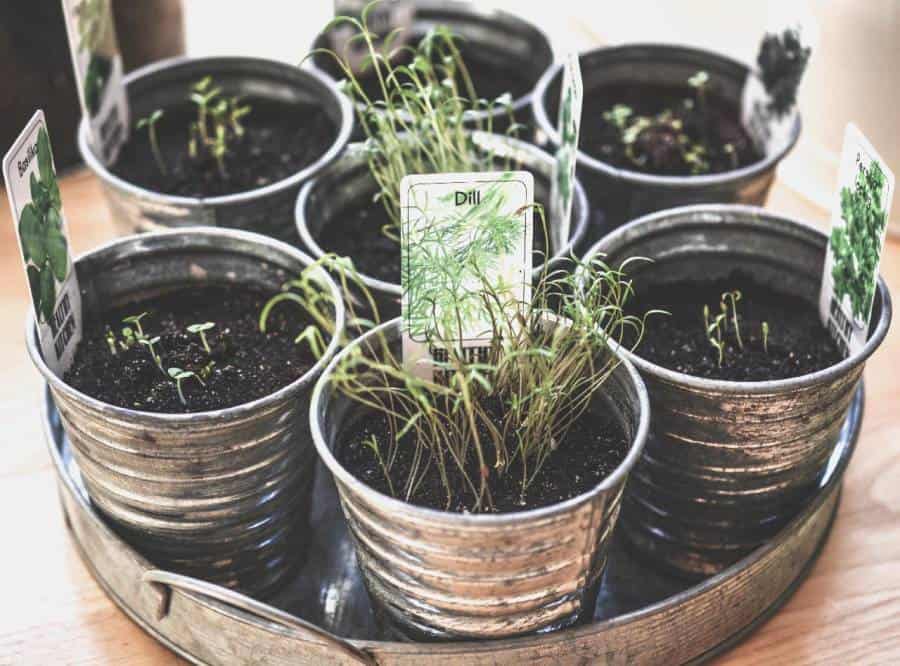
I plan to grow at least one herb in my balcony garden. That’s because herbs are easy to grow and are hardy plants.
They don’t need a lot of sunlight and can tolerate the wind that may blow on a balcony. You don’t need to have large pots to grow herbs. Most of them will be happy to grow in a 4 to 6 inch deep container.
Once they grow, you can keep harvesting the leaves for the entire growing season. And they will keep growing back. But once the growing season ends and they bolt, you won’t be able to eat them as they lose their taste.
There are a lot of choices you have when you want to grow herbs on your balcony. So pick one that you enjoy in your food.
I’ll be starting with cilantro as that’s a staple ingredient as a garnish in a lot of Indian dishes. I can give them to my family for cooking up some delicious meals.
| No | Plant | Container Size | Sunlight | Water |
| 1 | Mint | Depth – 6 inches
Width – 12 inches | At least 6 hours | 2 inches soil is dry |
| 2 | Rosemary | Depth – 6 inches
Width – 12 inches | At least 6 hours | 2 inches soil is dry |
| 3 | Cilantro | Depth – 12 inches
Width – 18 inches | At least 6 hours | Soil surface is dry |
| 4 | Lavender | Depth – 12 inches
Width – 12 inches | At least 6 hours | 2 inches soil is dry |
| 5 | Parsley | Depth – 8 inches
Width – 8 inches | At least 6 hours | Soil surface is dry |
| 6 | Basil | Depth – 8 inches
Width – 8 inches | At least 6 hours | Soil surface is dry |
| 7 | Tarragon | Depth – 6 inches
Width – 6 inches | At least 6 hours | 2 inches soil is dry |
| 8 | Thyme | Depth – 6 inches
Width – 8 inches | At least 6 hours | 2 inches soil is dry |
| 9 | Oregano | Depth – 8 inches
Width – 8 inches | At least 6 hours | 2 inches soil is dry |
| 10 | Sage | Depth – 8 inches
Width – 8 inches | At least 6 hours | 2 inches soil is dry |
| 11 | Dill | Depth – 12 inches
Width – 12 inches | At least 6 hours | 2 inches soil is dry |
Leafy Vegetables
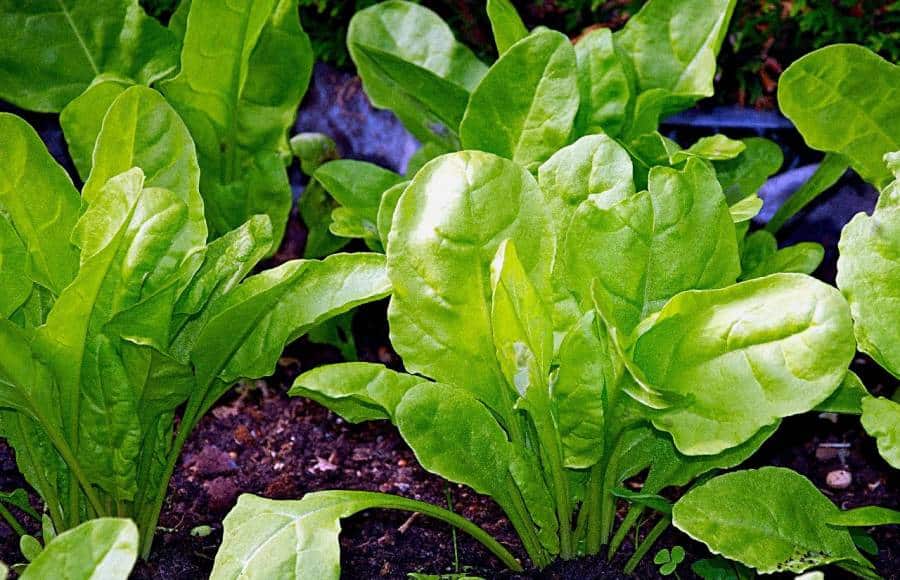
The other set of vegetables I want to grow on my balcony is leafy vegetables. These are also easy to grow in containers.
They don’t have much fuss when it comes to watering and how deep the container is. You can use a medium-sized container that is 8 to 10 inches to grow them.
Some of them don’t need much sunlight. Vegetables like lettuce and spinach prefer the shade and partial sun. If there’s intense sunlight they risk wilting or getting leaf burn.
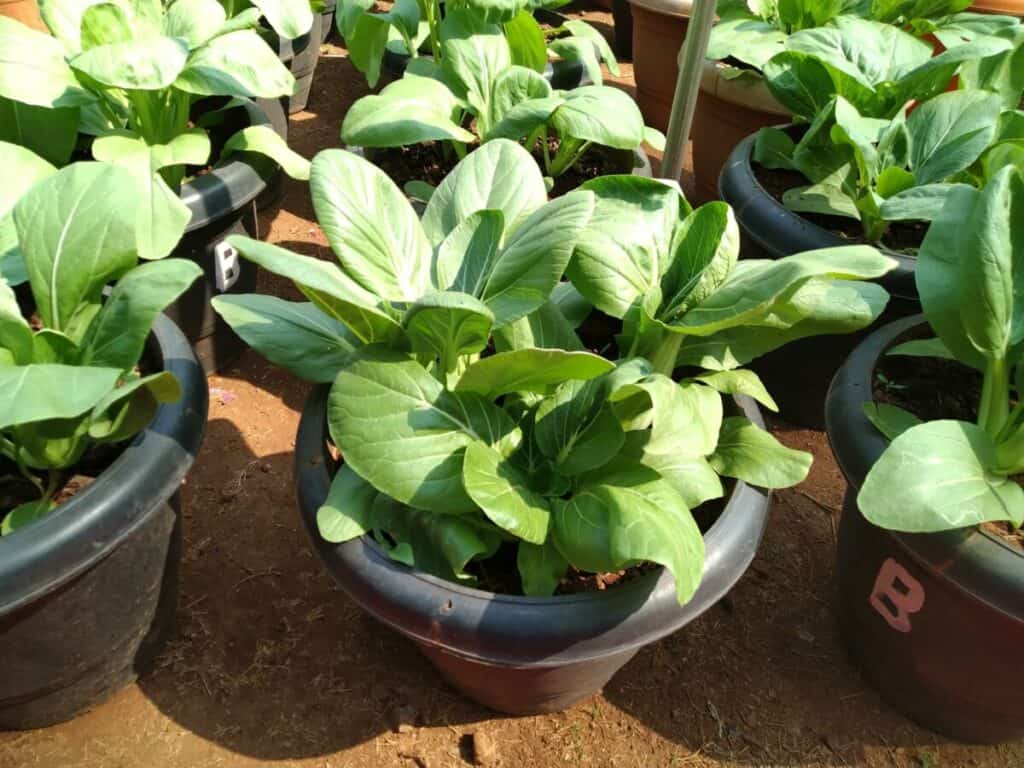
Like herbs, leafy vegetables will keep on growing as you keep harvesting the leaves. You can get a lot of salad for the entire season just with a few leafy vegetable containers on your balcony.
Spinach is going to be the leafy vegetable of my choice because I enjoy eating the leaves (and I am a big fan of Popeye).
| No | Plant | Container Size | Sunlight | Water |
| 12 | Celery | Depth – 8 inches
Width – 8 inches | At least 6 hours | Water every day |
| 13 | Lettuce | Depth – 6 inches
Width – 12 inches | At least 6 hours | Water every day |
| 14 | Kale | Depth – 12 inches
Width – 12 inches | At least 6 hours | 2 inches soil is dry |
| 15 | Mustard | Depth – 6 inches
Width – 6 inches | At least 6 hours | 2 inches soil is dry |
| 16 | Spinach | Depth – 6 inches
Width – 12 inches | At least 6 hours | 2 inches soil is dry |
| 17 | Bok choy | Depth – 20 inches
Width – 12 inches | At least 6 hours | Soil surface is dry |
| 18 | Broccoli | Depth – 12 inches
Width – 12 inches | At least 8 hours | 2 inches soil is dry |
| 19 | Brussel sprouts | Depth – 12 inches
Width – 12 inches | At least 6 hours | 2 inches soil is dry |
| 20 | Chard | Depth – 12 inches
Width – 12 inches | At least 6 hours | 2 inches soil is dry |
| 21 | Cabbage | Depth – 12 inches
Width – 12 inches | At least 6 hours | 2 inches soil is dry |
| 22 | Arugula | Depth – 8 inches
Width – 6 inches | At least 6 hours | 2 inches soil is dry |
| 23 | Collard greens | Depth – 12 inches
Width – 24 inches | At least 6 hours | 2 inches soil is dry |
| 24 | Cauliflower | Depth – 12 inches
Width – 12 inches | At least 6 hours | 2 inches soil is dry |
| 25 | Asparagus | Depth – 20 inches
Width – 20 inches | At least 6 hours | 2 inches soil is dry |
| 26 | Artichoke | Depth – 16 inches
Width – 16 inches | At least 6 hours | Water every day |
| 27 | Lemongrass | Depth – 8 inches
Width – 8 inches | At least 8 hours | 2 inches soil is dry |
| 28 | Leeks | Depth – 18 inches
Width – 18 inches | At least 6 hours | 2 inches soil is dry |
| 29 | Kohlrabi | Depth – 16 inches
Width – 16 inches | At least 6 hours | 2 inches soil is dry |
Fruit Vegetables
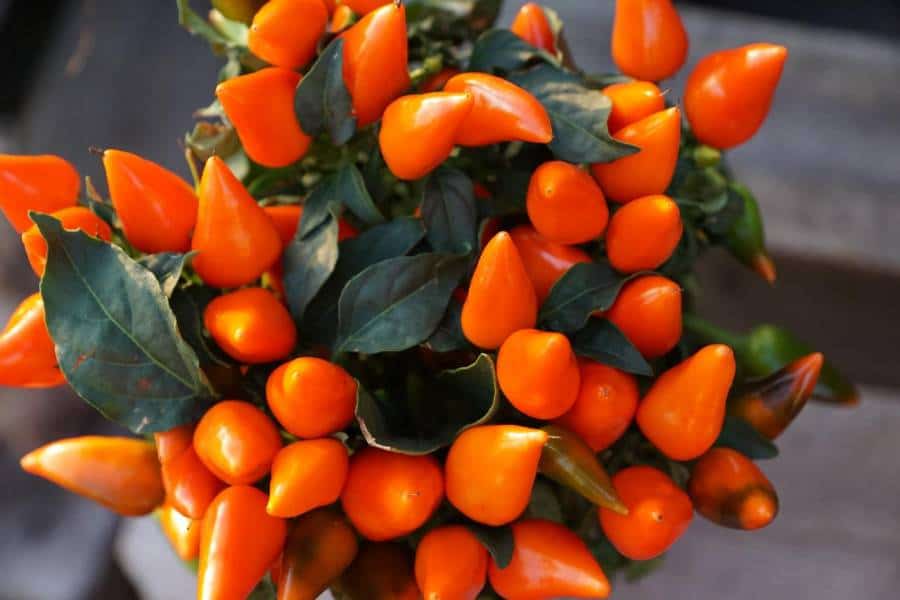
These are the vegetables that you will find colorful and full of flavor. Vegetables like tomatoes, peppers, and cucumbers.
They’re not that hard to grow in containers but do need a good amount of sunlight and watering. You also need to protect them from the wind as it can damage the plants.
My plan is to start growing some tomatoes in my balcony garden. I like the color and flavor of tomatoes. And I want to be growing at least one fruit vegetable as a challenge and learning.
You should pick vegetable varieties that are suitable for growing in a container. Some of these plants can grow quite large and heavy. It’s better to pick a bush or vining variety that your balcony can handle.
You don’t want too much weight on your balcony because of large and heavy containers and plants.
| No | Plant | Container Size | Sunlight | Water |
| 30 | Cucumbers | Depth – 12 inches
Width – 12 inches | At least 6 hours | 2 inches soil is dry |
| 31 | Tomatoes | Depth – 18 inches
Width – 18 inches | At least 8 hours | 2 inches soil is dry |
| 32 | Peppers | Depth – 12 inches
Width – 12 inches | At least 6 hours | 2 inches soil is dry |
| 33 | Zucchini | Depth – 12 inches
Width – 12 inches | At least 6 hours | 2 inches soil is dry |
| 34 | Summer squash | Depth – 12 inches
Width – 12 inches | At least 6 hours | 2 inches soil is dry |
| 35 | Eggplant | Depth – 14 inches
Width – 14 inches | At least 6 hours | 2 inches soil is dry |
| 36 | Tomatillo | Depth – 12 inches
Width – 12 inches | At least 8 hours | 2 inches soil is dry |
| 37 | Okra | Depth – 12 inches
Width – 12 inches | At least 6 hours | 2 inches soil is dry |
Root Vegetables
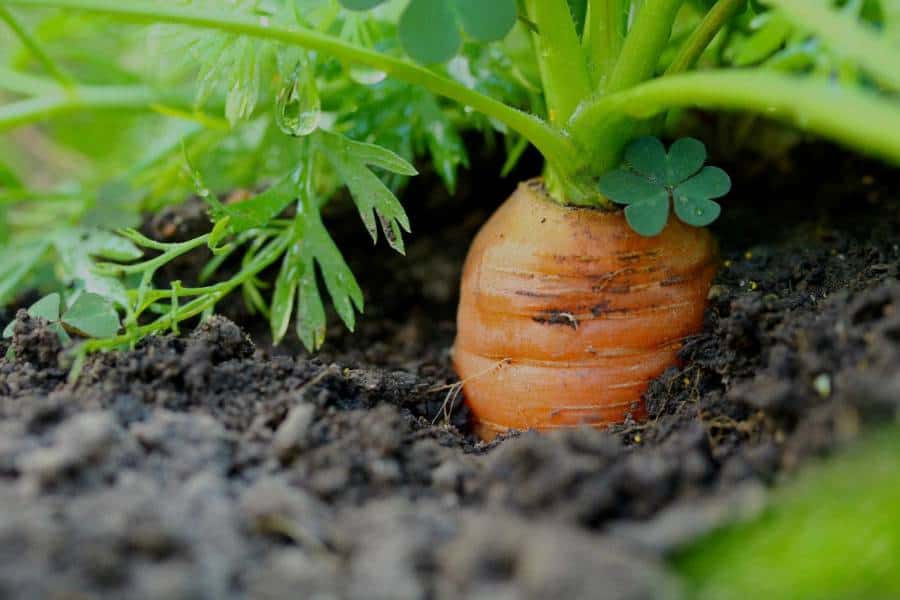
I used to think that root vegetables will be difficult to grow in a container because of the soil depth required.
But after looking at some of these vegetables, they are quite suitable to grow in a container. I will start with some radishes because they are fast and easy to grow.
They don’t require too deep a container and are happy to grow in soil that is 6 to 8 inches deep.
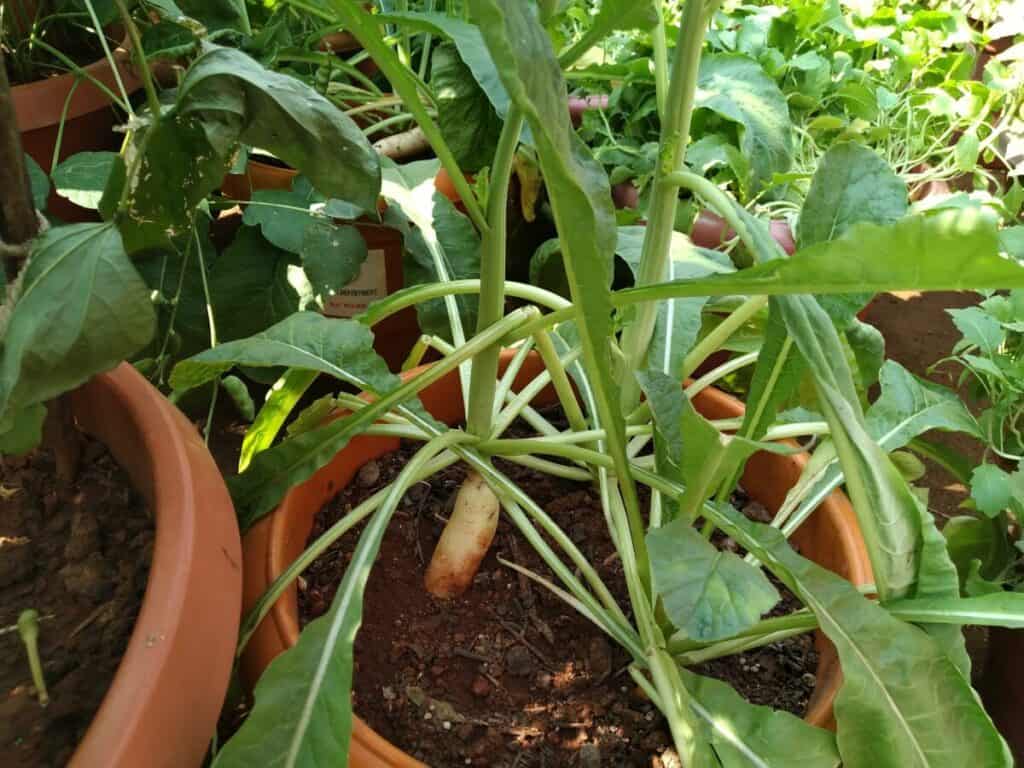
You are limited in how many root vegetables you can grow in the container as you need to keep some space between them. Otherwise, they will compete with each other for the nutrients and moisture.
Root vegetables don’t look as attractive as the herbs, leafy, or fruit vegetable plants. But they are a tasty and nutritious addition to our organic balcony garden.
| No | Plant | Container Size | Sunlight | Water |
| 38 | Radishes | Depth – 6 inches
Width – 16 inches | At least 6 hours | Soil surface is dry |
| 39 | Spring onions | Depth – 10 inches
Width – 24 inches | At least 6 hours | Soil surface is dry |
| 40 | Carrots | Depth – 12 inches
Width – 24 inches | At least 6 hours | Soil surface is dry |
| 41 | Beets | Depth – 12 inches
Width – 24 inches | At least 6 hours | Soil surface is dry |
| 42 | Potatoes | Depth – 16 inches
Width – 16 inches | At least 6 hours | Soil surface is dry |
| 43 | Garlic | Depth – 10 inches
Width – 12 inches | At least 6 hours | Soil surface is dry |
| 44 | Onions | Depth – 10 inches
Width – 12 inches | At least 6 hours | Soil surface is dry |
| 45 | Ginger | Depth – 16 inches
Width – 16 inches | At least 6 hours | Soil surface is dry |
| 46 | Chives | Depth – 8 inches
Width – 8 inches | At least 6 hours | Soil surface is dry |
| 47 | Turnips | Depth – 12 inches
Width – 12 inches | At least 6 hours | Soil surface is dry |
| 48 | Parsnips | Depth – 24 inches
Width – 24 inches | At least 6 hours | Soil surface is dry |
Seed Vegetables
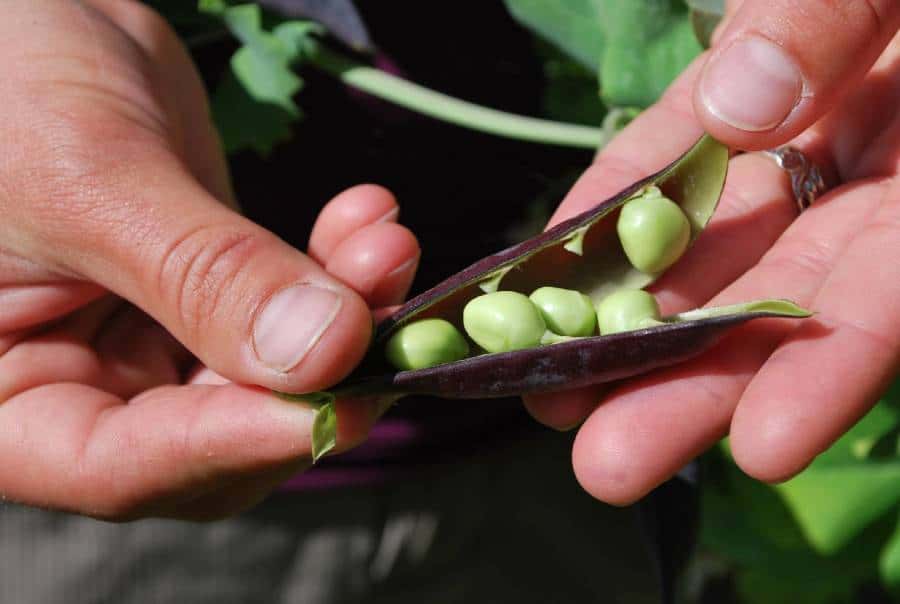
It’s easy to grow seed vegetables like beans and peas in your balcony garden as long as you can support them.
These usually are vining plants that like to stretch out. So growing them vertically in the balcony is the best choice to save space.
They need plenty of sunlight and moisture to grow well so make sure they get a good spot where these are available.
They are also a good choice to fix nitrogen into the soil. So you can grow them in one season and then grow a leafy vegetable in the soil after they’re done.
Growing beans or peas is not the first thing I’ll be doing. I’m spending my time on herbs, leafy vegetables, fruit, and root vegetables first. Once I gain some experience, I’ll add some seed vegetables to my balcony garden.
| No | Plant | Container Size | Sunlight | Water |
| 49 | Beans | Depth – 10 inches
Width – 10 inches | At least 6 hours | 2 inches soil is dry |
| 50 | Peas | Depth – 18 inches
Width – 18 inches | At least 6 hours | 2 inches soil is dry |
Mushrooms
51 Mushrooms
Mushrooms are not technically a vegetable but a fungus. You can grow them in your balcony garden as long as you know the process which is a bit different than growing other vegetables.
I don’t enjoy mushrooms as much so I won’t be growing them in my garden. But maybe when I want to improve my gardening skills I might give them a shot.
| No | Plant | Container Size | Sunlight | Water |
| 51 | Mushrooms | Depth – 12 inches
Width – 12 inches | No or low sunlight | Several sprinklings to keep soil moist |
I asked expert gardeners on what they think are easy to grow vegetables in a balcony, what they most enjoy about growing them, and why do they think it’s easy to grow. Below are what they told me,
Experts Comment On What Vegetables Are Easy To Grow In A Balcony
Melvin Cubian, Resident botany expert at PlantIn
Green, leafy vegetables, including lettuce, onion chives, spinach, and herbs, are the easiest to grow. Fruiting veggies, like tomato, pepper, chili, beans, or peas, are a bit more challenging than leafy veggies because of their extended cropping period than the leafy greens.
You can harvest them at any time, especially the salad greens. Uproot a 4-5 weeks-old baby lettuce for a fresh bowl or salad. If you postpone it for a few weeks more, you will harvest fully-grown greens, best enjoyed with other vegetables on the balcony.
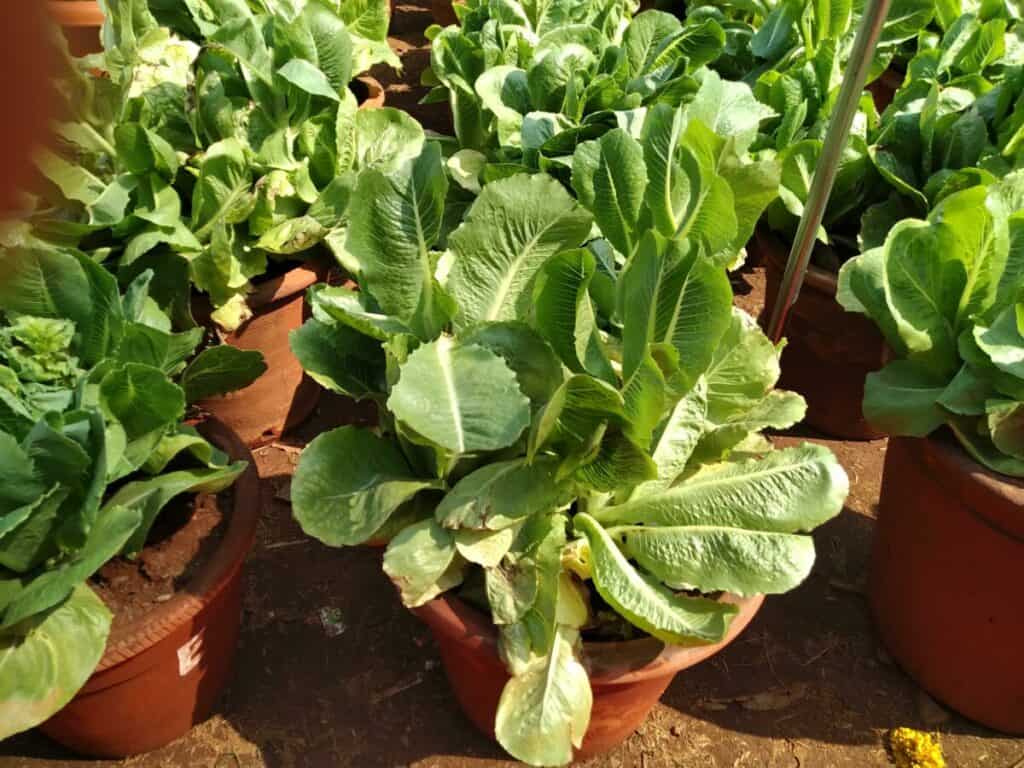
On the other hand, tomatoes, pepper, and chili ripen gradually, giving you time to plan your culinary creation. If you’re tempted to pick them while they’re still developing, you can do so; green or half ripe and can be consumed immediately or stimulated to mature faster by placing them in a plastic bag.
They are easy to grow because of their short cropping cycle, primarily the leafy veggies and herbs, as long as they are planted in suitable soil (equal mix of compost and standard soil), giving them enough nitrogen to grow leaves during the season. They also take up only a tiny space, unlike bushy varieties.
The fruiting ones would only need at least 1-2 fertilization (before and during flowering) supplements with phosphorus or potassium-rich fertilizers to ensure that the fruits grow to their maximum potential size.
Shelby DeVore, Gardener at Farminence
When I was in college I grew quite a bit of vegetables in my apartment and on a small patio. I found that smaller plants were the easiest. I grew a fair amount of leafy greens, lettuce, and herbs indoors. I found that I could grow those year-round inside. On the patio, I grew a lot of patio or dwarf varieties of larger plants. Tomatoes, peppers, and eggplants did really well as long as they got enough sunlight each day.
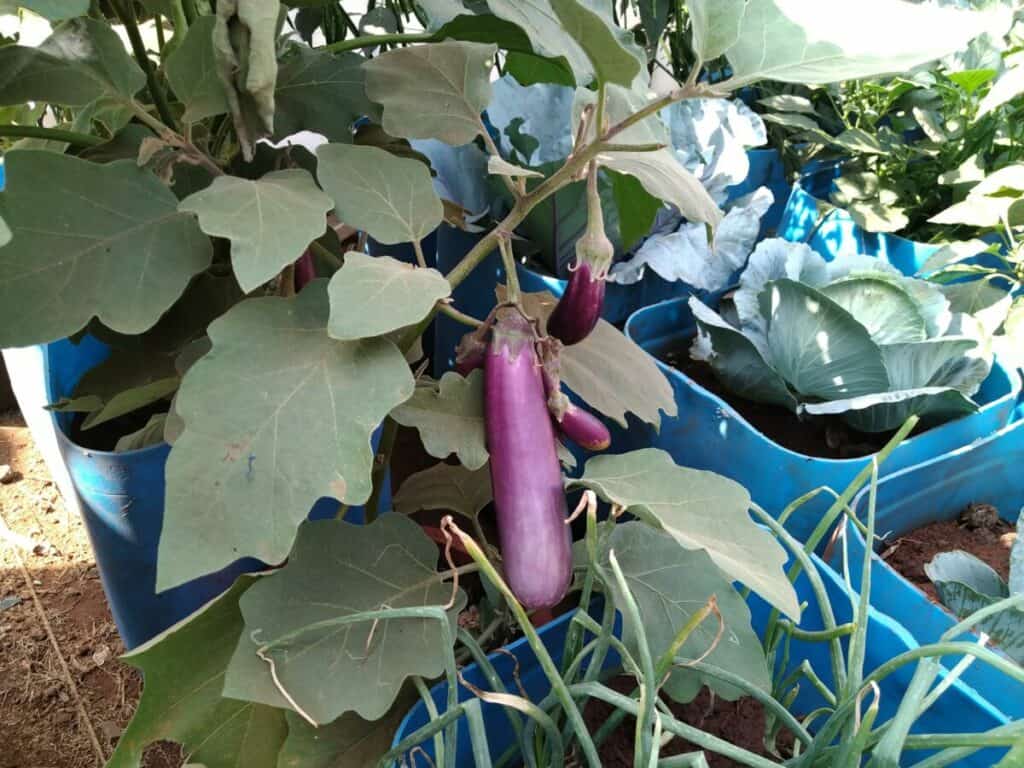
I enjoyed growing all of these because I used them frequently when I cook, so it made sense to grow them at home rather than buy them at the grocery store. They had much more flavor than what you can buy and I always knew they were really fresh.
Leafy greens were probably the easiest to grow because they don’t have the higher nutrient needs that some of the heavy feeders like tomatoes or peppers have. They also grow and mature faster so you feel like you’ve accomplished something sooner when growing them.
Cynthia Drachenberg is Founder at CynthiaDrachenberg.com
The easiest vegetables to grow on the balconies are lettuce, herbs, tomatoes, carrots, peas, and green beans. These are easy to grow, and it’s as simple as planting, watering, then occasionally pruning carrots or tying vines here and there.

These vegetables are great for a side salad or a quick snack and provide an abundance of health benefits, including fiber. They are also space-efficient vegetables which are important when growing on your balcony. For example, lettuce, herbs, and strawberries can be grown in hanging baskets, giving you more space. Tomatoes and carrots can be planted underneath in containers. Watering will also become efficient because as you water the hanging baskets, they trickle down into the containers underneath. As for peas and green beans, they have vines known to climb up, so putting them by the balcony side would be the perfect place.
Nikita Legall, Founder at Ah! Grow
When choosing what to grow it is essential to consider how many hours of sunlight your balcony area gets per day. Some vegetables do well in the shade while some require a full 6 to 8 hours of daily sunlight.
The easiest things to grow on an apartment balcony are seasonings (some people call them herbs and spices). things like chives, rosemary, various thyme varieties and mint are all good choices.
Herbs have a shallow root system so they can be grown in relatively small containers. What makes these easy to grow is that they aren’t often attacked by pests. Some herbs are known to deter pests because of their pungent odour.
One of the things I love about growing these herbs is that I have access to fresh seasonings at all times. This can make a big difference when cooking since the flavour is much stronger when freshly picked.
Kate Russell, Author of Stop Wasting Your Yard!
Having recently moved from a house with a big yard, fruit and nut trees, raised beds, chickens, and compost pile, into a two-bedroom highrise condo, I’ve learned a few things about growing vegetables indoors and on a balcony. I learned that it doesn’t matter how high up you are, stink bugs, leafhoppers, and many other garden pests will find your plants. My guess is that city insects are as desperate for fresh tomatoes and basil as we are.
I tried growing an apple tree on my balcony, but found that the pests were unbearable. Then we moved again into an apartment without a balcony, so I passed the tree on. If we still had a balcony, that tree would have been a long-term resident. Dwarf trees can produce a surprising amount of food for very little effort and you can keep them trained to a very small size.
Limited space makes favorites such as summer and winter squashes less realistic, so my favorite vegetables for apartment life are lettuce varieties, spinach, and herbs. Lettuce and spinach grow quickly and outer leaves can be harvested as-needed for quite a while. The variety of colors make them lovely on a windowsill. On another long windowsill I grow basil, cilantro, chives, parsely, thyme, and aloe. These plants don’t take up a lot of room and they add a big punch of flavor when I cook.
I think herbs and leafy greens are easy to grow for two very different reasons. Herbs evolved their delicious flavors as a deterrent to herbivore feeding in mostly rugged, rocky terrain. Tucked into a clay pot on a south-facing windowsill closely matches the conditions their ancestors grew in, so they seem to feel right at home. Lettuces and spinach grow quickly and continuously in nature so that they can store enough energy in their root systems to produce seeds in their second year. That speed makes it easy for us to make salads on a regular basis without leaving home.
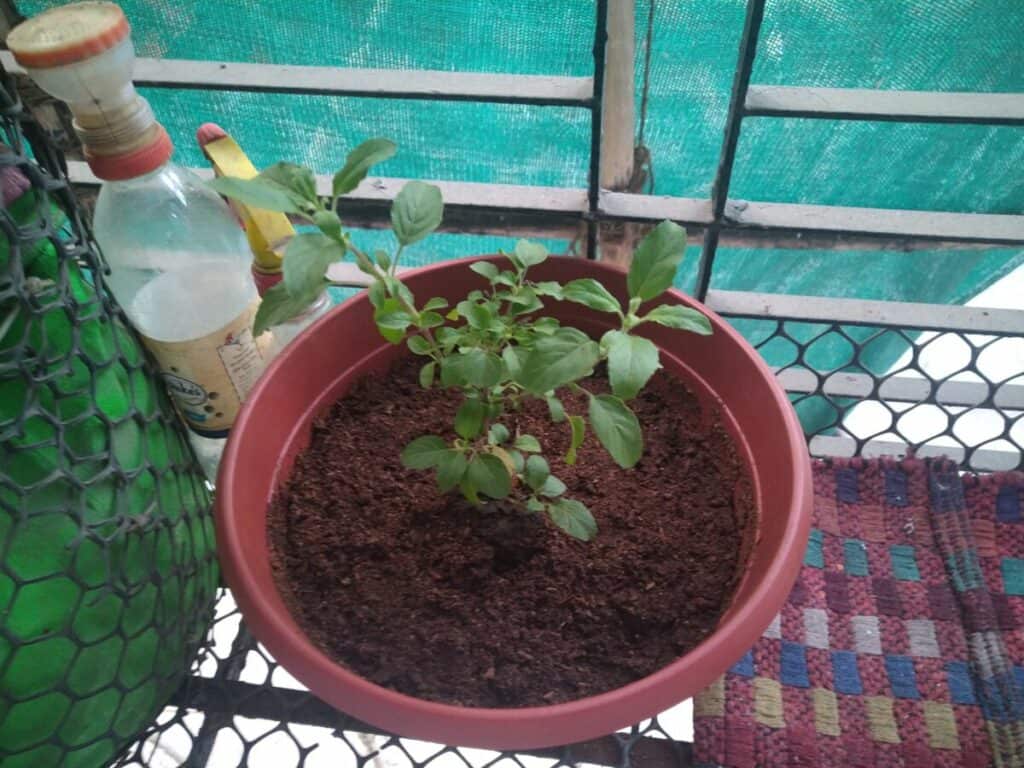
Jeremy Yamaguchi, CEO of Lawn Love
Lettuce and tomatoes are two easy vegetables to grow that are well suited to be grown on a balcony. Both can be grown in pots and are pretty low maintenance. Lettuce grows essentially all year, you just need to provide some shade for it during the hottest months and you may need to bring it inside during the winter. Other than that, it is sturdy and pretty difficult to kill. For tomatoes, you’ll want to plant them in a spot that gets full sunlight and has well draining soil. If you start with seedlings instead of a plant that has already begun growing, you’ll want to plant them indoors in a pot about a month before transplanting them outside.
Vladan Nikolic, Founder, Mr. Houseplant
There are several vegetables that are relatively easy to grow on a balcony and don’t require a lot of space. These include cherry tomatoes, peppers, and lettuce.
Vegetables require a great deal of energy to flower and produce fruits. That energy comes from light. So, to grow vegetables successfully the main ingredient is a lot of direct sun. Most people will be able to provide a sufficient amount of light on a balcony to grow vegetables.
For growing inside apartments I highly recommend getting a good, strong grow light. With good grow lights, a little bit of planning and care, it is possible to grow a wide variety of vegetables in a small space.
I love being able to grow my own, healthy, 100% natural food, with no harsh chemicals, in a small space. And if you use hydroponics, you can also save a ton of water. These vegetables are easy to grow as they don’t take up a ton of space and can mature relatively quickly.

Fact Checked, Written, and Published by Kevin Rodrigues
Kevin is the founder of Gardening Mentor, a website that aims to teach people to grow their own food in a limited space. As a self-taught gardener, Kevin has spent several years growing plants and creating gardening content on the website. He is certified in Home Horticulture and Organic Gardening from Oregon State University. He has a Post Graduate Diploma in Horticulture and Landscape Gardening from Mumbai University.
Read more
